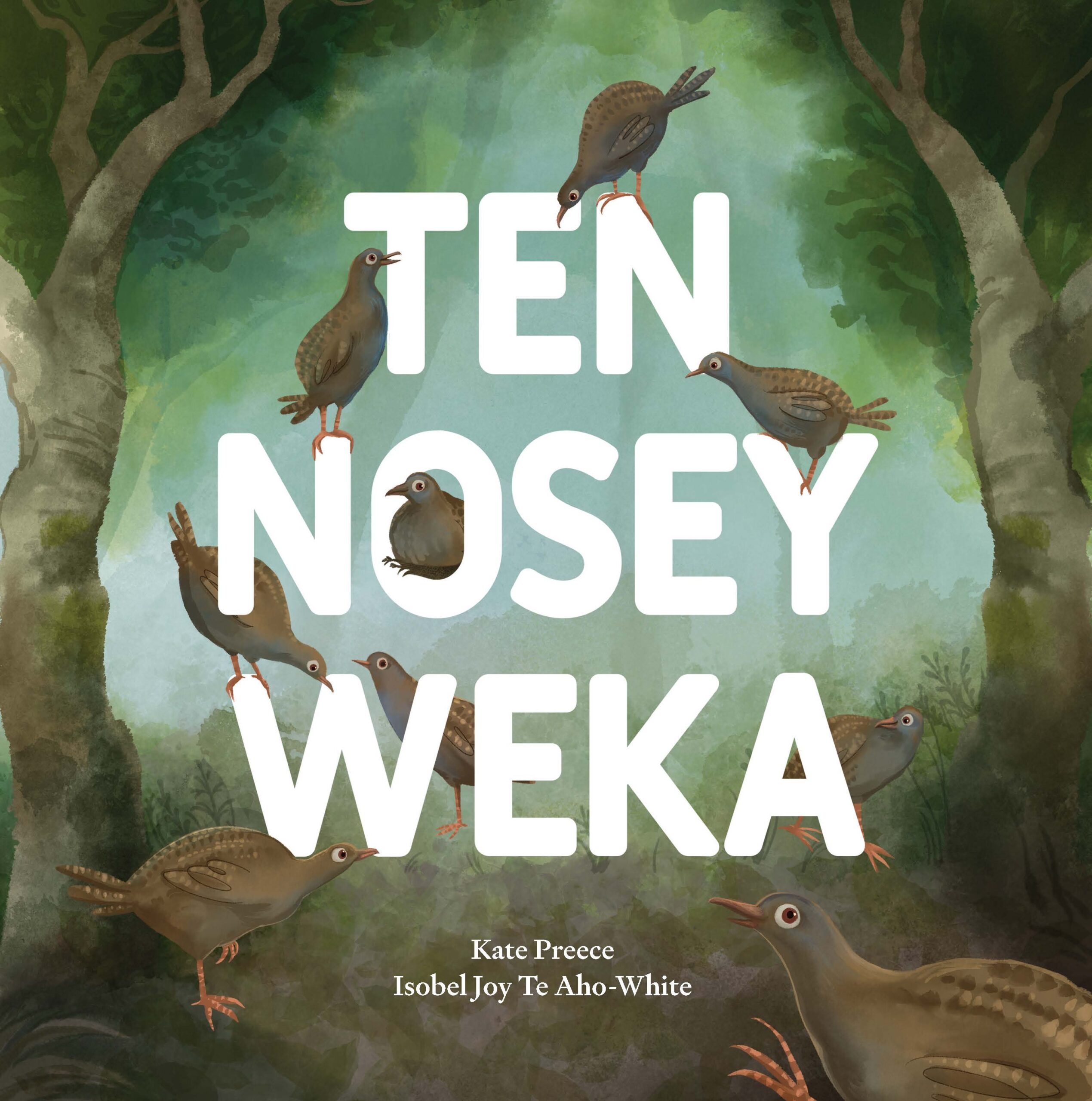Carly Thomas talks with Ten Nosey Weka author Kate Preece about creating a picture book that’s part of the ta rē Moriori revival.

A new children’s picture book by Kate Preece sits on the bookshop shelf alongside others. Its beautiful cover illustrations call you in, but it is the voice of this book that sets it apart as something special.
Ten Nosey Weka is a counting book with a difference—a trilingual first of its kind using ta rē Moriori alongside te reo Māori and English. Ta rē Moriori is the language of the original inhabitants of the Chatham Islands/Rēkohu/Wharekauri and in Kate’s book it sings out an ancestral hum. The Moriori language has walked very close to extinction over the years but through the work of Hokotehi Moriori Trust the ancient language is having a revival. And Kate says she is proud to be part of that; ‘After a stifling silence, there have been many efforts made to improve access to and the awareness of ta rē Moriori. When I first starting looking into what was available, though, the numbers one to 10 seemed confined to documents penned in the late 19th century. I wanted my children to experience the language of their karāpuna (tīpuna, ancestors), and, as an author, had the tools to do so, starting with tehi (tahi, one), teru (rua, two), toru (toru, three).’.
Kate moved to Rēkohu with her family in 2023, after making many trips to the island over the years with her husband, who is a weka (the nickname given to those from the island). It has been a big transition for the former editor relocating from the mainland to a big rock in the middle of the ocean, but she says the timing was right; ‘At the end of 2022, an opportunity came up for us to move to the family farm in Owenga. Our daughter was going into Year Eight, the last year taught on the island; cell phones worked (following the 2021 upgrade); and, thanks to a tech giant, wireless internet was just as good as on the mainland.’.

After a 14 year long career as an editor for Allied Press Magazines Kate turned her wordsmithing talents to writing children’s books and One Weta Went Walking was her debut. That book received a Storylines Notable Book Award in 2022 and the use of the curious native birds carried on into this latest book. ‘On early visits, weka made quite an impression on me. They’ll often cross the road on the drive to the airport, their necks stretched out like athletes willing their bodies across the line, but it’s their echoing chorus that stays with you, marking the end of a good day – and the start of another’.
The characterful wekas are woven into the counting book as they explore the Chatham Islands. Their numbers drop from 10 to one before the group gets drawn back together towards the common goal of a tasty snack. Kate uses repetition, rhyme, and rhythm and through this approach an interesting play of similarities and differences between the two indigenous languages shines out; ‘It is clear that while the two languages share roots, each has grown in its own direction. I’ve become quite passionate about ta rē Moriori, and love the ability to share this with my hūnau (whānau, family), through the gathering of vocabulary, and the writing of a few children’s songs.’.

Illustrator Isobel Joy Te Aho-White was tasked with the job of bringing the book to life and Kate says without her work the words ‘would have merely been black and white’. Using a blend of digital art and watercolour/ink techniques Isobel utilised the moody and magical island colour palette to capture Kate’s everyday vistas. She also included a number of extra Rēkohu residents, such as the Chatham Island blue penguins and the Chatham Island oystercatchers—neither of which can be found anywhere else in the world. ‘Isobel plotted out the scenes on a map of Rēkohu before taking these tengahuru (ten, tekau) weka on an adventure around the motchu (island, motu).’
At the back of the book there is a brief history of the language and the people who are helping push it back up towards the light. It takes perseverance to step out of the shadows and for Kate, ‘getting Ten Nosey Weka published meant the next generation could have what my husband did not’.

‘It’s been two years since I first submitted Ten Nosey Weka to publishers—pushing for the next generation to have what my husband did not. He grew up not knowing how to count to 10 in the language of his karāpuna (ancestors/tīpuna), and I wanted things to be different for our children. Ten Nosey Weka will see ta rē Moriori in homes around the country which is hugely exciting. It’s prompting all the right conversations, too; the ones that build awareness around a people and a place often overlooked.’
And that excitement and passion has got Kate on a roll now. She has another children’s book coming out later this year, A Butterfly Fluttered By, and a ‘watch this space’ hope for a novel to go from a first draft to a fully realised book in the near future. But for now, those nosey weka are Kate’s whimsical vehicle for spreading the word, the very special word, of ta rē Moriori.

Ten Nosey Weka
By Kate Preece
Illustrated by Isobel Joy Te Aho-White
Published by Bateman Books
RRP: $21.99

Carly Thomas
Carly Thomas is a freelance writer living in rural Manawatu. She juggles a list of writing gigs that can get wonderfully eclectic.



